SUBARU IMPREZA WRX 2004 2.G Repair Manual
Manufacturer: SUBARU, Model Year: 2004, Model line: IMPREZA WRX, Model: SUBARU IMPREZA WRX 2004 2.GPages: 491, PDF Size: 5.93 MB
Page 61 of 491

1-34
Seat, seatbelt and SRS airbags
dren are safer when properly restrained in the
rear seating positions than in the front seating
positions.
SINCE YOUR VEHICLE IS EQUIPPED WITH A PASSENGER’S SRS AIRBAG, NEVER INSTALL
A REARWARD FACING CHILD SAFETY SEAT
IN THE FRONT PASSENGER’S SEAT. DOING SO RISKS SERIOUS INJURY OR DEATH TO
THE CHILD BY PLACING THE CHILD’S HEAD
TOO CLOSE TO THE SRS AIRBAG.
! Choosing a child restraint system
Choose a child restraint system that is appropriate for
the child’s age and size (weight and height) in order to
provide the child with proper protection. The child re-
straint system should meet all applicable requirements
of Federal Motor Vehicle Safety Standards for the
United States or of Canada Motor Vehicle Safety
Standards for Canada. It can be identified by looking
for the label on the child restraint system or the manu-
facturer’s statement of compliance in the document at-
HG1043BAUGS507AA
Page 62 of 491
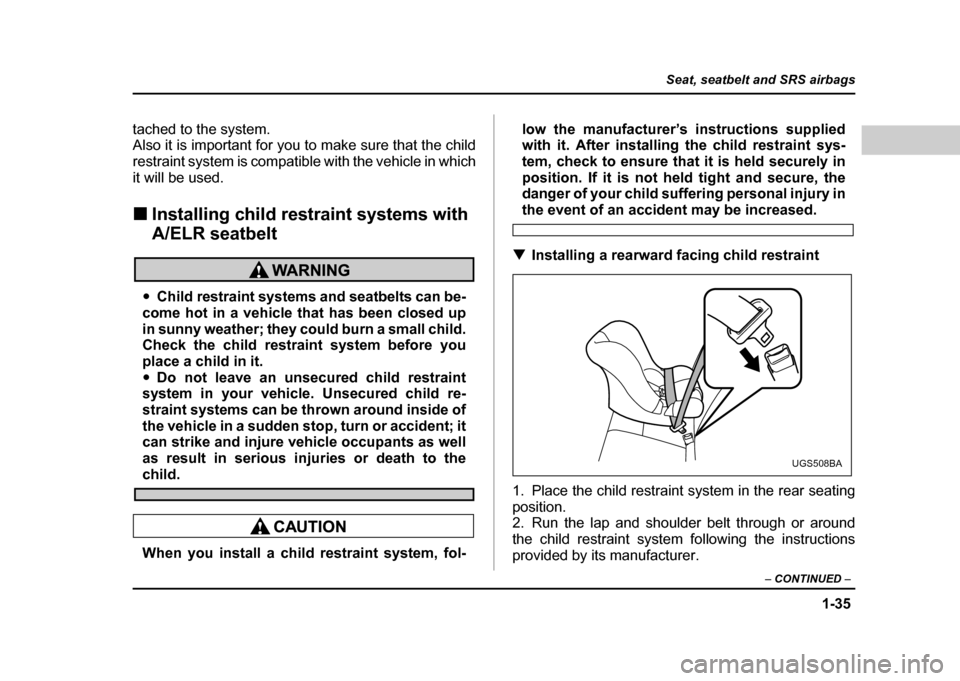
1-35
Seat, seatbelt and SRS airbags
– CONTINUED –
tached to the system.
Also it is important for you to make sure that the child
restraint system is compatible with the vehicle in which
it will be used. !Installing child restraint systems with
A/ELR seatbelt
"Child restraint systems and seatbelts can be-
come hot in a vehicle that has been closed up
in sunny weather; they could burn a small child.
Check the child restraint system before you
place a child in it." Do not leave an unsecured child restraint
system in your vehicle. Unsecured child re-
straint systems can be thrown around inside of
the vehicle in a sudden stop, turn or accident; it
can strike and injure vehicle occupants as well
as result in serious injuries or death to the
child.
When you install a child restraint system, fol- low the manufacturer’s instructions supplied
with it. After installing the child restraint sys-
tem, check to ensure that it is held securely in
position. If it is not held tight and secure, the
danger of your child suffering personal injury in
the event of an accident may be increased.
! Installing a rearward facing child restraint
1. Place the child restraint system in the rear seating
position.
2. Run the lap and shoulder belt through or around
the child restraint system following the instructions
provided by its manufacturer.
UGS508BA
Page 63 of 491
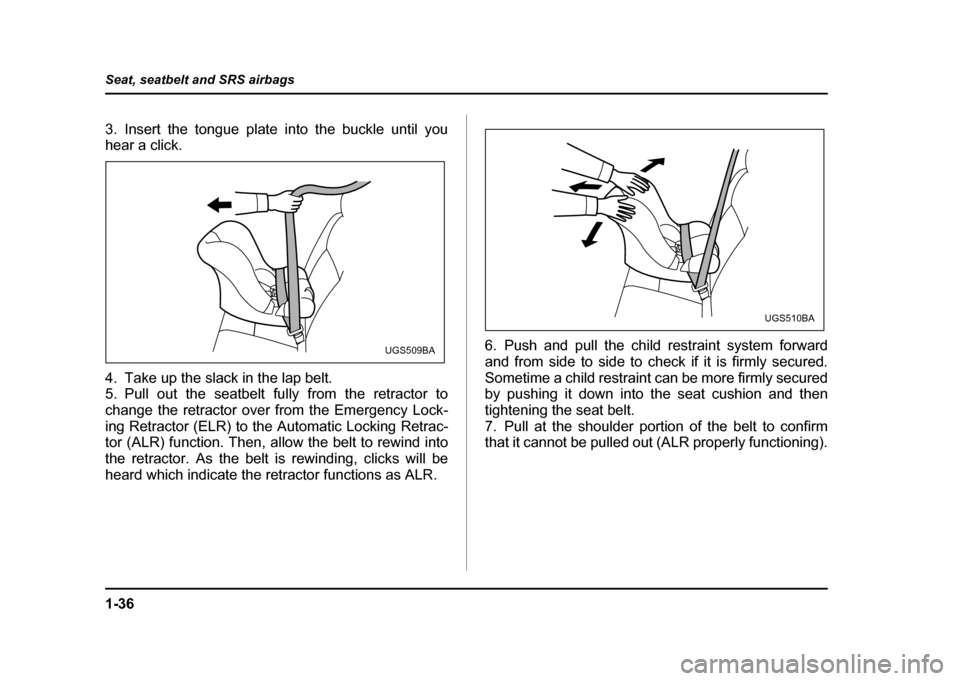
1-36
Seat, seatbelt and SRS airbags
3. Insert the tongue plate into the buckle until you
hear a click.
4. Take up the slack in the lap belt.
5. Pull out the seatbelt fully from the retractor to
change the retractor over from the Emergency Lock-
ing Retractor (ELR) to the Automatic Locking Retrac-
tor (ALR) function. Then, allow the belt to rewind into
the retractor. As the belt is rewinding, clicks will be
heard which indicate the retractor functions as ALR.
6. Push and pull the child restraint system forward
and from side to side to check if it is firmly secured.
Sometime a child restraint can be more firmly secured
by pushing it down into the seat cushion and then
tightening the seat belt.
7. Pull at the shoulder portion of the belt to confirm
that it cannot be pulled out (ALR properly functioning).
UGS509BA
UGS510BA
Page 64 of 491
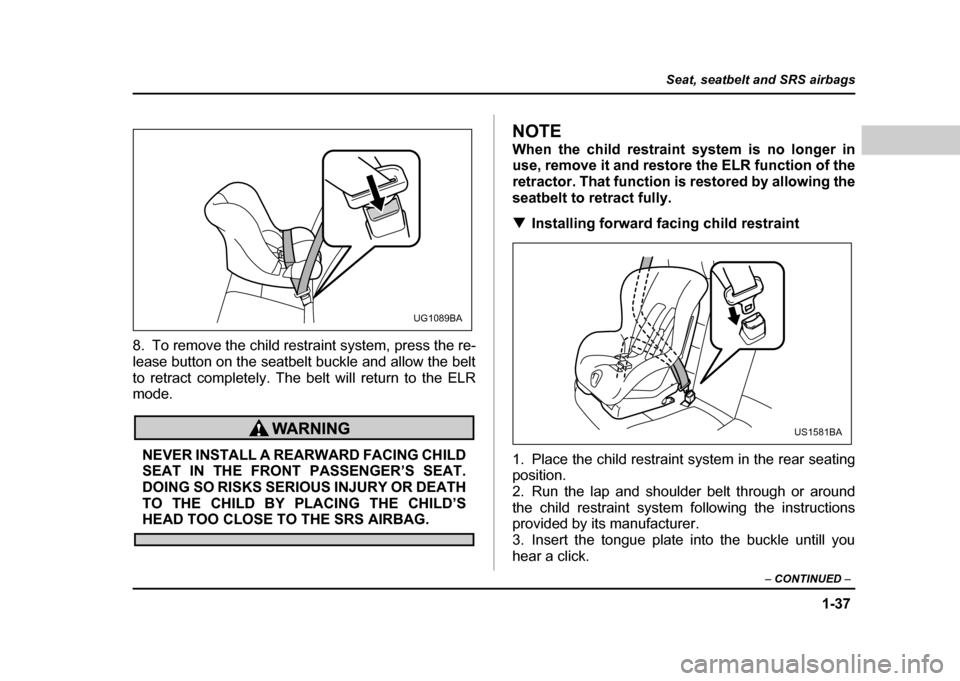
1-37
Seat, seatbelt and SRS airbags
– CONTINUED –
8. To remove the child restraint system, press the re-
lease button on the seatbelt buckle and allow the belt
to retract completely. The belt will return to the ELR
mode.
NEVER INSTALL A REARWARD FACING CHILD
SEAT IN THE FRONT PASSENGER’S SEAT.
DOING SO RISKS SERIOUS INJURY OR DEATH
TO THE CHILD BY PLACING THE CHILD’S
HEAD TOO CLOSE TO THE SRS AIRBAG.
NOTE
When the child restraint system is no longer in
use, remove it and restore the ELR function of the
retractor. That function is restored by allowing the
seatbelt to retract fully. !Installing forward facing child restraint
1. Place the child restraint system in the rear seating
position.
2. Run the lap and shoulder belt through or around
the child restraint system following the instructions
provided by its manufacturer.
3. Insert the tongue plate into the buckle untill you
hear a click.
UG1089BA
US1581BA
Page 65 of 491

1-38
Seat, seatbelt and SRS airbags
4. Take up the slack in the lap belt.
5. Pull out the seatbelt fully from the retractor to
change the retractor over from the Emergency Lock-
ing Retractor (ELR) to the Automatic Locking Retrac-
tor (ALR) function. Then, allow the belt to rewind into
the retractor. As the belt is rewinding, clicks will be
heard which indicate the retractor functions as ALR.
6. Before having a child sit in the child restraint sys-
tem, move it back and forth and right and left to check
if it is firmly secured. Sometimes a child restraint can
be more firmly secured by pushing it down into the
seat cushion and then tightening the seatbelt.
7. Pull at the shoulder portion of the belt to confirm
that it cannot be pulled out (ALR properly functioning).
US1582BAUS1583BA
Page 66 of 491
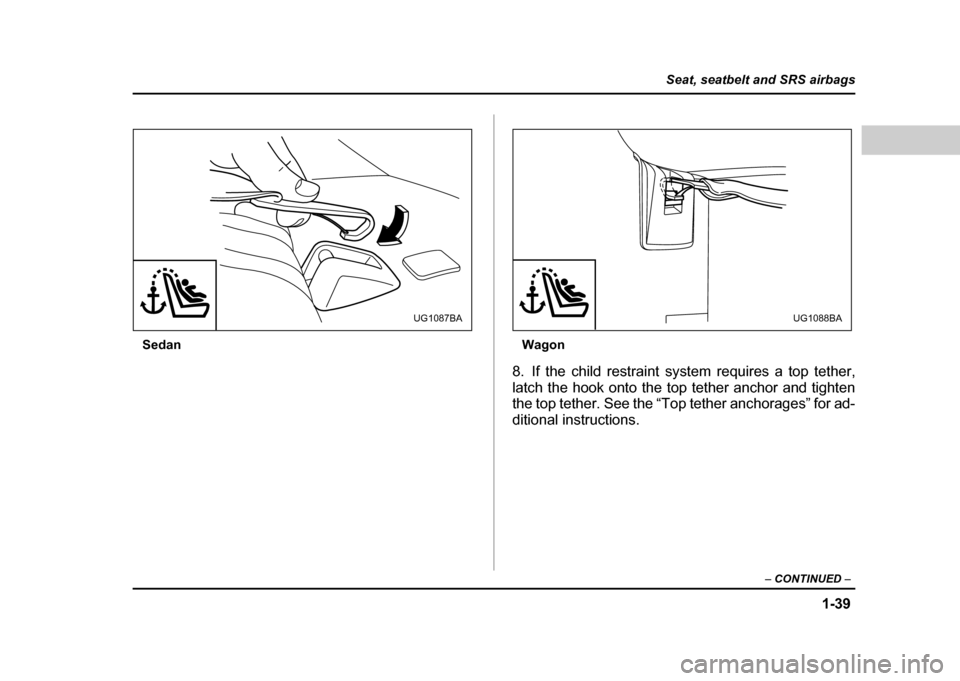
1-39
Seat, seatbelt and SRS airbags
– CONTINUED –
Sedan Wagon
8. If the child restraint system requires a top tether,
latch the hook onto the top tether anchor and tighten
the top tether. See the “Top tether anchorages” for ad-
ditional instructions.
UG1087BAUG1088BA
Page 67 of 491
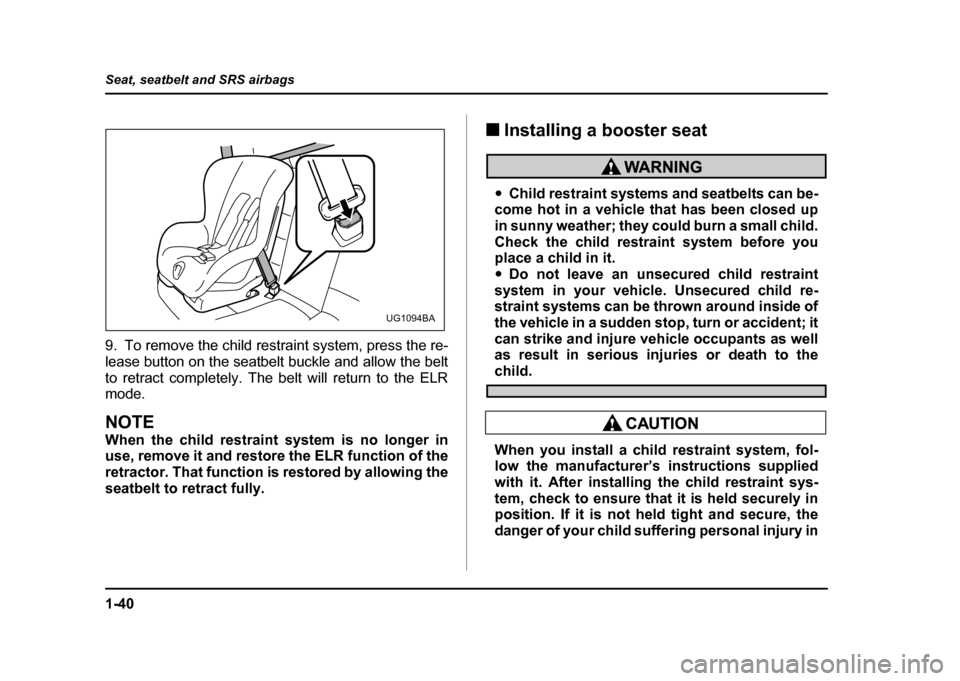
1-40
Seat, seatbelt and SRS airbags
9. To remove the child restraint system, press the re-
lease button on the seatbelt buckle and allow the belt
to retract completely. The belt will return to the ELR
mode.
NOTE
When the child restraint system is no longer in
use, remove it and restore the ELR function of the
retractor. That function is restored by allowing the
seatbelt to retract fully.
!
Installing a booster seat
"Child restraint systems and seatbelts can be-
come hot in a vehicle that has been closed up
in sunny weather; they could burn a small child.
Check the child restraint system before you
place a child in it. " Do not leave an unsecured child restraint
system in your vehicle. Unsecured child re-
straint systems can be thrown around inside of
the vehicle in a sudden stop, turn or accident; it
can strike and injure vehicle occupants as well
as result in serious injuries or death to the
child.
When you install a child restraint system, fol-
low the manufacturer’s instructions supplied
with it. After installing the child restraint sys-
tem, check to ensure that it is held securely in
position. If it is not held tight and secure, the
danger of your child suffering personal injury in
UG1094BA
Page 68 of 491
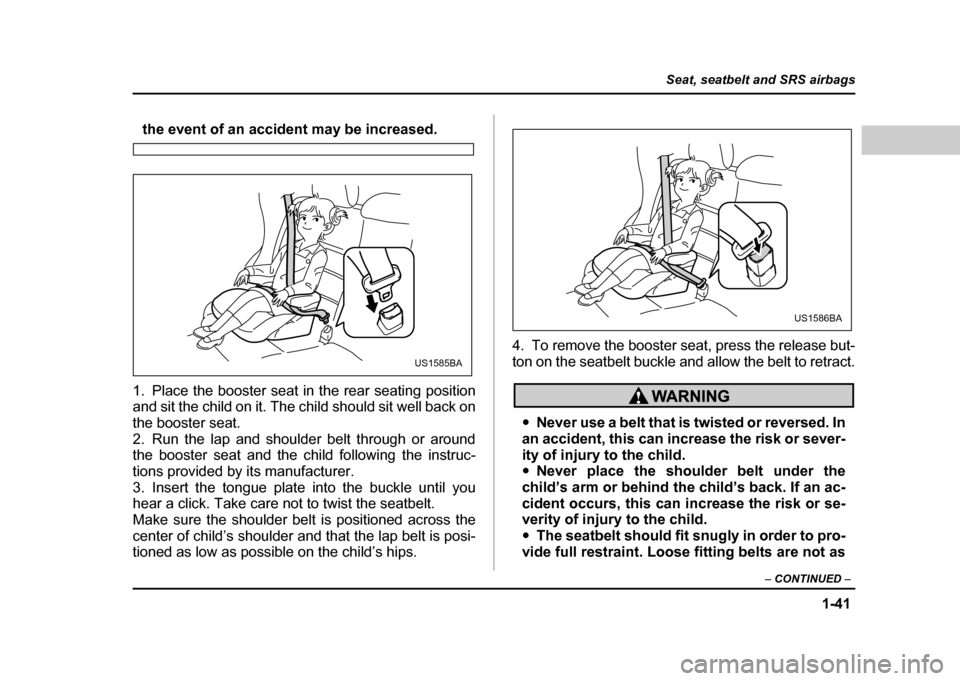
1-41
Seat, seatbelt and SRS airbags
– CONTINUED –
the event of an accident may be increased.
1. Place the booster seat in the rear seating position
and sit the child on it. The child should sit well back on
the booster seat.
2. Run the lap and shoulder belt through or around
the booster seat and the child following the instruc-
tions provided by its manufacturer.
3. Insert the tongue plate into the buckle until you
hear a click. Take care not to twist the seatbelt.
Make sure the shoulder belt is positioned across the
center of child’s shoulder and that the lap belt is posi-
tioned as low as possible on the child’s hips. 4. To remove the booster seat, press the release but-
ton on the seatbelt buckle and allow the belt to retract.
"
Never use a belt that is twisted or reversed. In
an accident, this can increase the risk or sever-
ity of injury to the child. " Never place the shoulder belt under the
child’s arm or behind the child’s back. If an ac-
cident occurs, this can increase the risk or se-
verity of injury to the child. " The seatbelt should fit snugly in order to pro-
vide full restraint. Loose fitting belts are not as
US1585BA
US1586BA
Page 69 of 491
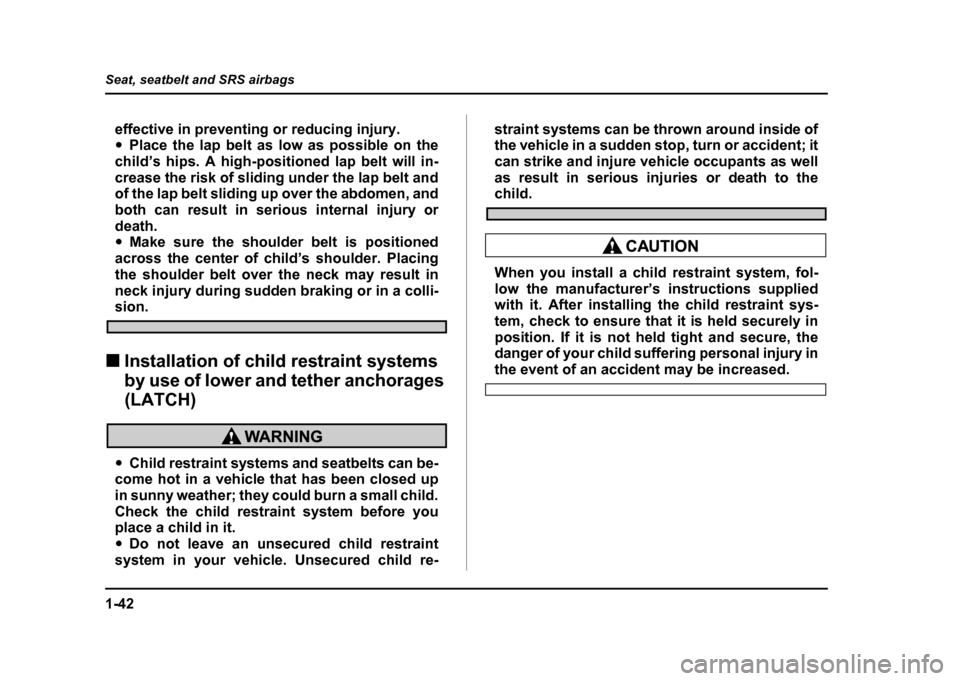
1-42
Seat, seatbelt and SRS airbags
effective in preventing or reducing injury. "
Place the lap belt as low as possible on the
child’s hips. A high-positioned lap belt will in-
crease the risk of sliding under the lap belt and
of the lap belt sliding up over the abdomen, and
both can result in serious internal injury or
death. " Make sure the shoulder belt is positioned
across the center of child’s shoulder. Placing
the shoulder belt over the neck may result in
neck injury during sudden braking or in a colli-
sion.
! Installation of child restraint systems
by use of lower and tether anchorages (LATCH)
"Child restraint systems and seatbelts can be-
come hot in a vehicle that has been closed up
in sunny weather; they could burn a small child.
Check the child restraint system before you
place a child in it. " Do not leave an unsecured child restraint
system in your vehicle. Unsecured child re- straint systems can be thrown around inside of
the vehicle in a sudden stop, turn or accident; it
can strike and injure vehicle occupants as well
as result in serious injuries or death to the
child.
When you install a child restraint system, fol-
low the manufacturer’s instructions supplied
with it. After installing the child restraint sys-
tem, check to ensure that it is held securely in
position. If it is not held tight and secure, the
danger of your child suffering personal injury in
the event of an accident may be increased.
Page 70 of 491
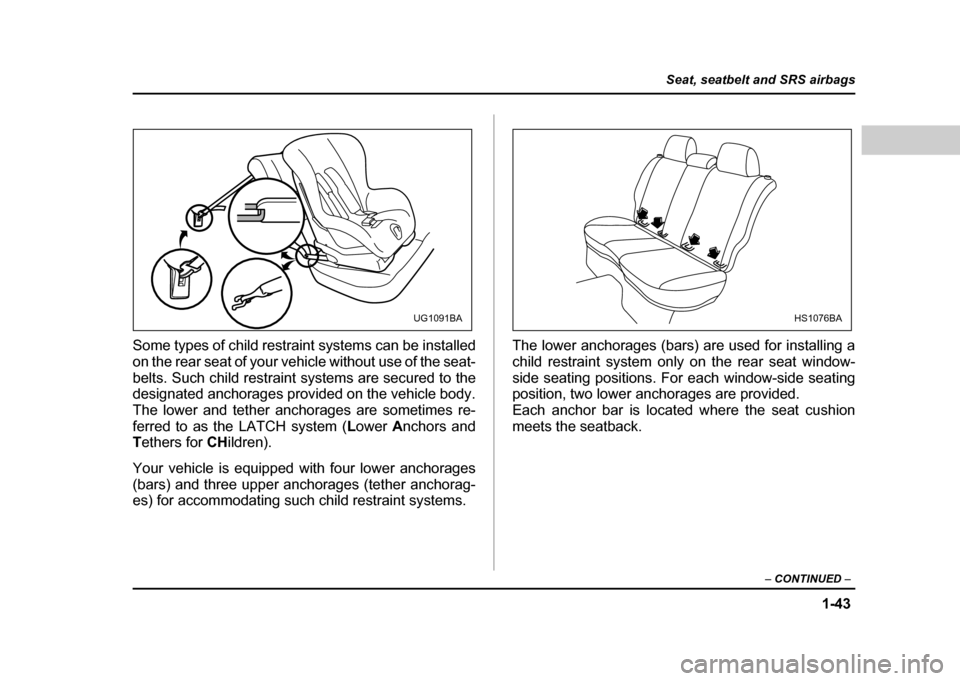
1-43
Seat, seatbelt and SRS airbags
– CONTINUED –
Some types of child restraint systems can be installed
on the rear seat of your vehicle without use of the seat-
belts. Such child restraint systems are secured to the
designated anchorages provided on the vehicle body.
The lower and tether anchorages are sometimes re-
ferred to as the LATCH system ( Lower Anchors and
T ethers for CHildren).
Your vehicle is equipped with four lower anchorages
(bars) and three upper anchorages (tether anchorag-
es) for accommodating such child restraint systems. The lower anchorages (bars) are used for installing a
child restraint system only on the rear seat window-
side seating positions. For each window-side seating
position, two lower anchorages are provided.
Each anchor bar is located where the seat cushionmeets the seatback.
UG1091BAHS1076BA